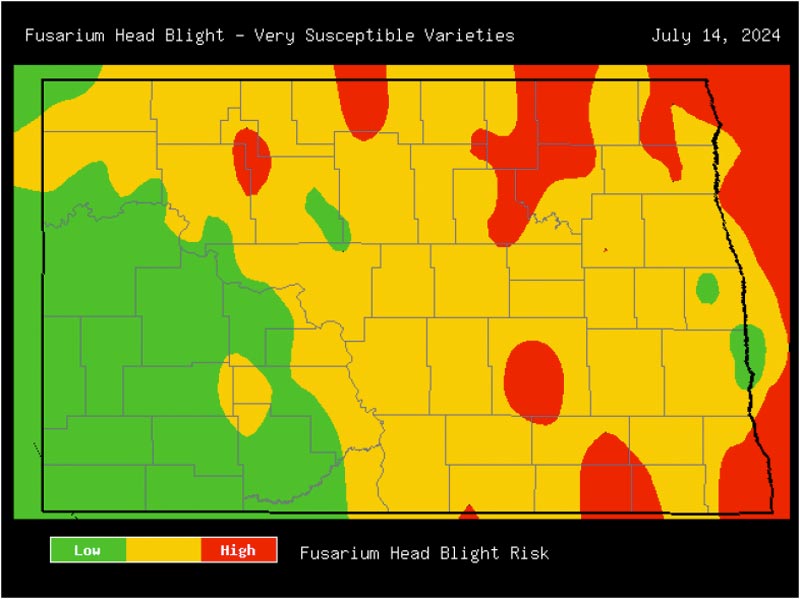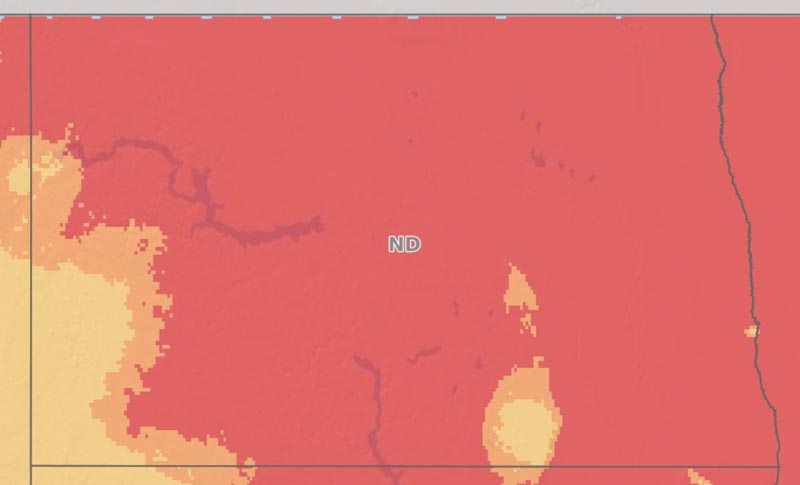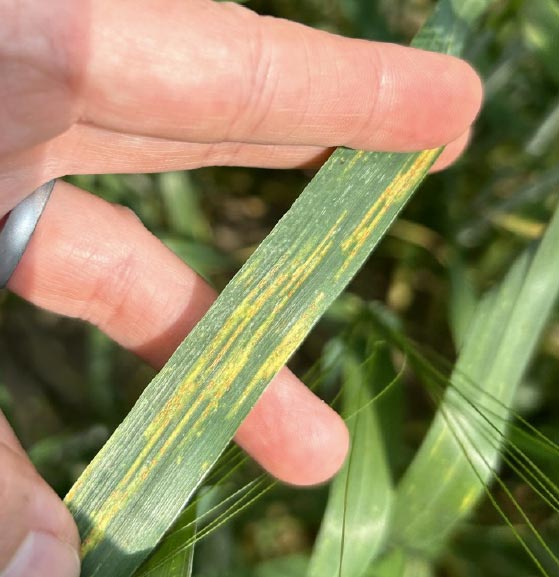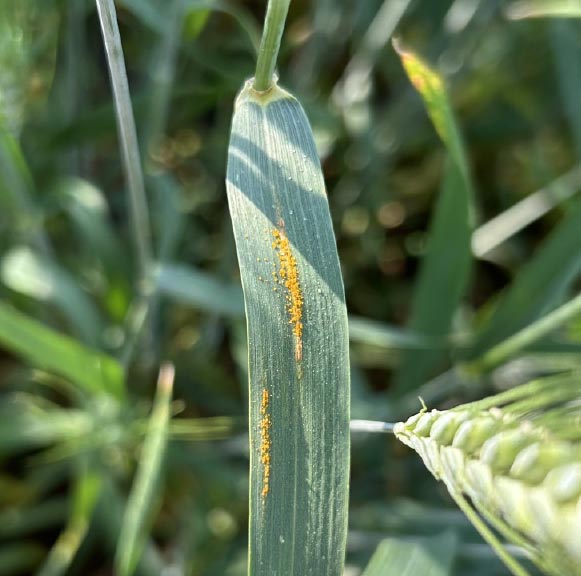Agronomy Update
Jul 15, 2024
Current Head Scab Risk
Despite high temps in the 90s last week, The risk of scab remains elevated across much of the state due to humid conditions. Below are the NDSU Small Grains Disease Forecasting Model scab risk map (top) and the National Fusarium Risk Tool map (bottom) for very susceptible varieties of HRSW or durum flowering July 14th or July 15th respectively. Durum, susceptible varieties of HRSW and barley that are flowering or heading in the case of barley, this week are likely still at risk. We will continue to report and gauge risk for the later planted crop.

As you are making the decision on whether or not to apply a fungicide at the early flowering timing in durum or wheat, remember it is not just scab you are managing, but also the foliar diseases which can affect the flag leaf causing yield loss. I found stripe rust on the flag leaf in four fields last week (pictures below), and fungal leaf spotting diseases (ex. Tan spot) were also common. This is the legacy of the cool and wet weather we had previously in the season. Scientists have studied the effect of flag leaf removal on yield loss and found that removing the flag leaf can result in yield loss of 9—40% depending on the variety. That is why it is critical to protect the flag leaf during this key growth stage as the crop is trying to produce grain.
Dr. Audrey Kalil, Agronomist/Outreach Coordinator
 |
 |
The Importance of Soil Sampling
The bulk of this season’s in-crop work has been done and for most we are switching gears (at least mentally) to prepare for harvest, but I challenge you to think further ahead into next year. Commodities and Inputs are at an intersection that will be far more challenging for return, so why not look at site specific placement of fertilizer to maximize returns. If you have ever considered site specific fertility applications, the time is right now to be looking at your fields for evidence that not every square foot performs the same. Look at these examples from two different fields I work with. If you fertilize for a 50-bushel yield goal on these fields, would you treat the poor, average and above average zones the same? Or if you had the ability, would you prefer to put less on those poorer areas and give more to the most productive areas of the field.
If you see that areas within fields vary in productivity, you’ll also likely agree that the good and poor areas are always in the same locations year to year. So why not have zone maps built for your fields’ productivity zones and have them soil sampled after harvest this year? One of the easiest things you can do to increase the ROI on your farm is to have accurate soil sampling done, and zone-based soil sampling will give you a much more accurate result vs traditional composite soil sampling.
Kyle Okke, Crop Consultant, CCA

Fungicide Applications for White Mold in Soybean
We have received some questions about fungicide selection and timing last week for soybean, so as the crop enters flowering I wanted to take the opportunity to discuss the research that has been conducted by Dr. Michael Wunsch, Plant Pathologist at the NDSU Carrington REC. He has done extensive research on white mold in North Dakota and his findings have developed guiding principles for managing this disease in soybeans, which I will discuss below.The first thing to consider is the canopy of your crop as it enters bloom: is it open or closed? If it is open, you can improve control up to 11% by delaying your fungicide application from late R1 to early R2. If the canopy is closed, it does not help to delay application and you should stick with the late R1 timing. R1 is when there is one open blossom on the plant, and R2 is when there is an open blossom on the top two nodes of the plant. Canopy status will also affect the droplet size you should use. When the canopy is closed using a course droplet instead of a fine droplet can improve control by 3% and yield by 3 bu./ac compared to a fine droplet. When the canopy is open a fine droplet size maximizes control. The reason for this is that the disease starts on the lower parts of the plant and when the canopy is open a fine droplet will provide coverage, but as the canopy closes you need a course droplet to penetrate the canopy and reach the lower areas of the plant. To assist with canopy penetration we have a product called Masterlock that you can add to the tank, which is a combination NIS, drift reductant and canopy penetrant.
Fungicide selection is extremely important, as not all products can control this disease. Headline, for example, is not labeled for control of white mold. Endura is an excellent product on white mold in soybeans and other crops, and it is usually part of the white mold management program either as a solo application or in a rotation. Dr. Wunsch has found that Miravis Neo and Revytek were generally less effective than Endura for white mold control in soybeans, while ProPulse and Topsin can provide similar levels of control. Delaro Complete shows potential as a white mold product, but more data is needed. If you have questions about management of white mold in soybean please feel free to reach out to our agronomy locations.
Dr. Audrey Kalil, Agronomist/Outreach Coordinator